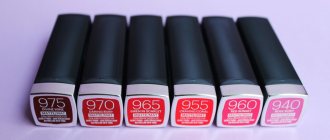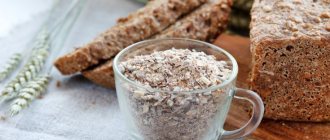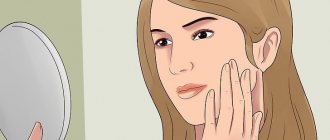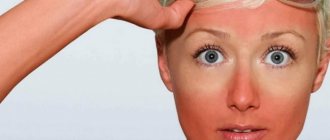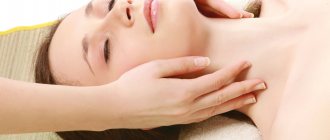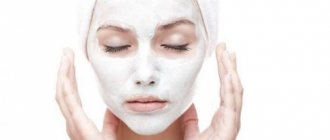Facial skin care is a mandatory procedure to preserve youth and prevent the appearance of wrinkles and age-related changes.
Cosmetologists strongly recommend nourishing and moisturizing the skin at least 2 times a day. However, many women are faced with a situation where their face sweats after applying the cream.
The causes of this problem may be substances contained in the cosmetic product, allergic reactions and diseases.
Reasons for separation
What is the difference between a day face cream and a night cream? The first difference is in purpose.
Recently, facial skin care products have become divided into night and day care products. The reasons are quite understandable. The upper layers of the epidermis become dehydrated during the night, which causes wrinkles to appear.
This means that the skin needs to be moisturized in the morning. And only a day cream can cope with this task. However, keep in mind that you need to apply it to your face immediately after waking up. There is no point in using it when several hours have already passed.
This product for daytime use includes carefully selected ingredients that can restore lost moisture and improve the functioning of the sebaceous glands. It is indispensable as protection against ultraviolet rays, wind, and nicotine smoke.
Night cream can saturate the skin with nutrients. One of the basic rules for its use is that it should be applied a couple of hours before bedtime. You need to give it time to absorb a sufficient amount of the product. Before going to bed, you need to remove the excess with a damp cloth.
Note! Modern nanocosmetics are quite suitable for applying them immediately before bed. Its uniqueness lies in the fact that microscopic particles are able to penetrate the layers of the epidermis instantly.
Accordingly, the next morning the face will not be swollen, the pores will not be clogged with cream, and the face will not look greasy. This product will become a lifesaver for women who do not have the opportunity to carry out the procedure a couple of hours before bedtime.
Day and skin type
Normal type (tendency to slight dryness)
Even if your facial skin is in normal condition, you can’t help but take care of it. Otherwise, sooner or later problems will begin. Therefore, it is necessary to carefully study the composition. It should include components such as:
- Vitamins A, E, C;
- Glycerol;
- Hyaluronic acid;
- Coenzyme Q10;
- Ceramides.
Dry type
The cream for dry skin is based on acid. Oil formulations are not used during the day, as they contain extracts of aloe, olive tree, and vitamin E. Exceptions are argan or grape oil.
Fat type
Oily skin needs to be moisturized with ceramides, chamomile extract, hyaluronic acid, aloe vera. There are creams without hyaluronic acid in the composition; they are based on plant extracts.
Wrinkles
To create an anti-wrinkle day cream, several anti-aging ingredients are used. The composition usually includes dimethicone, hyaluronic acid, ceramides, peptides, and calendula extract.
Dry skin + acne
It would seem that acne can only appear on oily skin, and it is necessary to use a day cream specifically for this type. But what if your skin is dry, despite the presence of acne? After all, using a remedy for dry skin can only make the situation worse.
There is a solution: choose formulations without oils, but with AHA acid. They have a moisturizing and exfoliating effect.
Night and skin type
Night face cream is designed to work while you sleep. The difference between night cream and day cream, in addition to its purpose, is also in the composition. The composition of the night includes such components as:
- vitamin supplements;
- cosmetic oils;
- elastin;
- collagen.
Thanks to its regenerating properties, the skin will gain a second youth after its regular use. But getting exactly this result depends on the right selection.
Dry type
A night cream for dry skin must contain fats. Thanks to this, an invisible film is formed on the face. This is necessary to retain moisture.
In addition, the composition includes almond, shea butter, rose and jojoba oils.
Fat type
A cream for oily skin should not contain fats, or rather, their minimal presence is acceptable. In addition, the composition contains salicylic acid, zinc and ginseng.
Sensitive type
For this skin type, creams have been developed that contain the following natural ingredients: calendula, chamomile, licorice. Thanks to them, the face will be protected from adverse environmental factors.
Normal type
For normal skin, night cream with seaweed is perfect. They give a good restorative effect. By the way, it is also suitable for other types.
How to apply moisturizing and nourishing creams to your face
Preparation
- The first thing you need to do is wash your hands to keep them clean. Otherwise, particles of dust and dirt can be introduced into the pores.
- If there is makeup on the face, it must be removed with milk or micellar water.
- The skin needs to be cleansed, even if you have cleaned it of makeup.
- After this, you need to treat the skin with tonic.
Now you can start applying the cream.
Step by step procedure for applying cream to face
Step 1.
First you need to apply the cream pointwise.
Depending on the consistency of the cream, you can vary the number of dots. The denser the cream, the more difficult it will be to distribute over the skin, so the number of dots may be greater than when applying a cream with a lighter texture.
The cream is applied to the forehead, nose, cheekbones and chin.
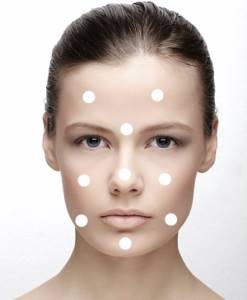
An approximate diagram of spot application of cream on the face
Step 2.
Then you need to carefully distribute the cream strictly along the massage lines. Try not to stretch the skin.
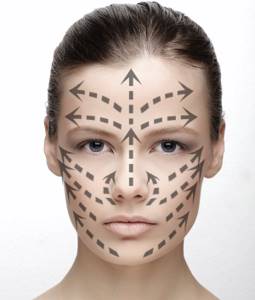
Facial massage lines
Step 3.
After distributing the cream over the entire face, you need to beat it into the skin with gentle patting movements.
By the way, many cosmetologists recommend applying the cream this way, without distributing it along massage lines. However, not all creams have such a consistency that the cream is distributed evenly in this way.
Step 4.
If there is a lot of cream, then you need to remove the remains with a napkin or paper towel. In this case, under no circumstances should you rub the skin. This must be done with applying movements.
What if you mix up the jars?
Can day cream be used as night cream?
You cannot use night cream instead of day cream and vice versa.
Otherwise, the most unpleasant changes will occur to the skin. It will have an oily sheen all day, and will have a negative reaction when exposed to sunlight. In addition, peeling and even swelling will appear.
If you use a day cream as a night cream, then the skin will not receive the nutrients that are contained in a real night cream.
There are universal products designed for use both at night and during the day. They contain components that complement each other.
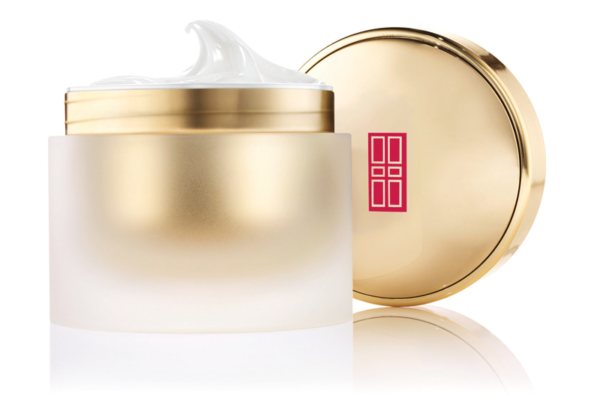
Tip No. 1. You should choose night and day cream from the same line. Either way, they will complement each other well, which will improve the effect of their use.
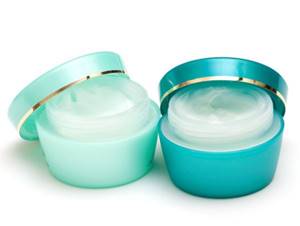
Tip No. 2. We must not forget about the thin skin of the eyelids. For the eyelids, you also need to have two products: day and night. It is desirable that they be in the form of a gel.
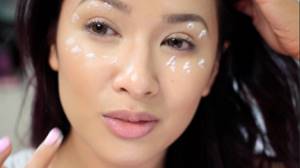
So, we have decided that the difference between day and night cream is in the purpose, composition and time of application. Therefore, the question: “which cream is better day or night” is in itself incorrect. Both are necessary. Properly selected creams will help maintain a youthful face. They will protect it around the clock, not allowing external factors to have a negative impact.
How to use creams correctly
Golden rules for applying cream:
1. Before applying the cream, you need to distribute it on the phalanges of your fingers and rub it lightly, warming it up to body temperature. This technique will speed up the absorption of the cream.
2. The cream is best applied to dry skin. After cleansing the skin, wait at least 15 minutes. Dry skin is more permeable to cosmetics; Applying creams to wet skin leads to stagnation of heat and disruption of thermoregulation.
3. Apply the cream to your face with light circular movements along the massage lines, without making any effort. The massage is designed to stimulate nerve endings and activate blood circulation, and not move the skin, causing the formation of new wrinkles.
4. The daytime product does not need to be applied immediately before going outside, because the top layer of skin is loosened and the skin’s protective reaction is reduced. Especially if it is windy, damp or frosty outside, then you can go out into the fresh air at least half an hour after applying the cream. The night remedy must be applied one and a half to two hours before bedtime, and then be sure to remove the residue with a napkin.
5. The skin receives beneficial substances from the nourishing cream within sixty minutes after application, and then actively “digests it.” Therefore, after an hour, the remaining cream can be removed with a napkin.
6. Try to change nourishing creams throughout the year.
7. Try feeding your skin with products from several manufacturers. The different composition will stimulate the functioning of the epidermis and will not allow the skin to “get used to” and “get lazy.”
8. You should not use nourishing creams daily. Sometimes (for example, once or twice a week), the skin needs to be given rest and the opportunity to work on its own - breathe through the pores and secrete natural fat.
9. Regardless of the condition of the skin, the cream is always applied in the amount necessary only for light, uniform lubrication of the surface. After 10 minutes, there should be no traces left on the face from applying the cream; excess should be removed with a napkin. For one-time use, a pea-sized amount of medication is sufficient.
10. Areas of unwanted hair growth (temple, upper lip, chin, eyebrow fold) should be avoided by applying nourishing and fortified cream - they stimulate hair growth. For these areas, moisturizers are quite sufficient.
And now about how to apply the cream correctly:
1. Let's distribute a small amount of the cream that we are going to “treat” our skin over the entire forehead - with the fingertips of both hands. We perform movements alternately in opposite directions.
2. Apply the cream with the tips of your index fingers, first to the area under the eyes, moving from the temples to the nose, then onto the eyelids - in the direction from the nose to the temples.
3. To smooth out the face, evenly distribute the cream from the middle of the chin to the nose, without touching the lips, to the cheekbones and temples. We press barely on the skin.
4. Apply the cream to the neck on the left and right, alternately. Smooth the skin with your fingers, moving up from the chin along the oval of the face to the ears. Then we run our open palm from the chin to the base of the neck.
5. With the outer side of the palm, lightly pat the lower part of the chin with frequent, energetic, but very light movements.
An important condition: when applying the cream, your hands should be relaxed so that when you touch your face, you get the impression of softness and tenderness.
How to properly apply cream to the skin around the eyes?
It is applied from the inner corner of the eye along the upper eyelid to the outer corner of the eye and from there along the lower eyelid again to the inner corner of the eye. The 4th finger works - it is the laziest and weakest. The movements are very easy. Do not stretch the skin, it is very thin on the eyelids. Don't apply too much cream. Perform the procedure an hour and a half before bedtime.
It is important not only to apply the cream correctly to the skin, but also to get it at the right time. After all, our skin lives according to its own internal clock and creams must be used in accordance with its biorhythms. Each of them has their own work schedule, but patterns can also be traced.
Biorhythms of our skin:
4 - 7 hours. A lightweight moisturizer with a high water content, vitamins and minerals is best. At this time, the endocrine glands begin to activate, hormones are actively released, and blood circulation becomes intense. The skin easily absorbs moisture and substances dissolved in it.
8 - 10 o'clock. A protective day cream is best. Blood circulation at its peak. The skin is like a sponge, absorbing everything it comes into contact with. It’s good if she comes across a protective day cream that protects against moisture loss and ultraviolet radiation, and not with dust and poisons from polluted air.
11 - 12 o'clock. Mattifying creams are the best. The sebaceous glands begin to work with a vengeance. An oily sheen appears on the skin, pores are most noticeable, so it is recommended to apply mattifying creams.
13 - 14 hours . The skin is tired and looks faded. Wrinkles become more noticeable. The face needs rest: washing with cool water and wiping with a tonic lotion.
15 - 18 hours. The skin is absolutely immune to cosmetic procedures. At this time, the functions of excretion dominate over its ability to absorb.
18 - 23 hours. Cleaning products. The skin's sensitivity increases, and it absorbs oxygen most actively.
23 - 5 o'clock. The skin intensively absorbs biologically active and nutrients contained in night creams.
You should still try to apply creams before 10:30 pm; if you apply the cream later than this time, swelling may appear in the morning. The washing system can be carried out after 22:30 if you do not have time.
Knowing the biorhythms of skin life, you can use day and night creams to greater advantage.
©

